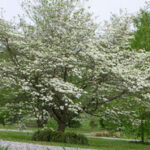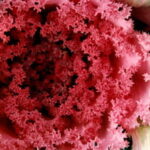Native Americans and early American settlers have prized the flowering dogwood tree as far back as the 1700’s. Today they are primarily valued for their delicate white or pink flowers and purplish fall leaves. They are popular in home landscaping as well as commercial and are still prevalent in forest stands as understory trees, peeking out from beneath taller trees. Dogwoods are among the first to bloom in the spring, giving their owners an added benefit of early flowers.
Description of the Dogwood Tree
An ornamental tree, the flowering dogwood produces small, 4-petaled flowers, called bracts, very early in the spring. Some varieties are pink in color but most and those found primarily in the wild are white. Each petal has red spot on the center of the outer edge, giving it a focal point. Flowering dogwoods average 15 feet in height but can soar to 30 feet in the right conditions. The bark displays a block-like appearance. Fall leaves turn a purple shade. Birds, squirrels and deer are fans of the small red berries it produces. The leaves turn a purple color in the fall. It produces small red berries favored by squirrels and birds. The longevity of flowering dogwoods is about 80 years.
Habitat of the Dogwood Tree
Flowering dogwoods can grow in a variety of soils but prefer moist, well-drained soil. Adaptable, they can grow equally well in the shadowy understory of fuller, taller trees or in the wide open, sun-bathed yards of homeowners. Their range in the United States stretches from Kansas and Texas northward and eastward to Michigan and Massachusetts. Europe, Asia and the United States are all native homes to the flowering dogwood.
Disease Facts of the Dogwood Tree
Dogwood blight is fungus that can affect the flowering dogwood. Discovered in the 1970’s, it has spread throughout the natural range of the tree by the 1990’s. The leaves first show spots with purple edges before dropping off. Once the disease set in the trees dies within 2 to 3 years. Other diseases that can affect the flowering dogwood are cankers, powdery mildew and leaf blight. While these diseases are not fatal, they, like dogwood blight, are caused by overly damp conditions.
State Flower or Tree
Thomas Jefferson is credited with being a huge fan of the flowering dogwood as evidenced by the quantity he planted at his Monticello home in Virginia in the 1770’s. Virginians came to love the tree and its delicate blooms and made it their state flower in 1918. This was not enough and the tree was later named as Virginia’s state tree in 1956 as well. North Carolina adopted it as their state flower 1941 while Missouri waited until 1955 to adopt the flowering dogwood as its state tree.
Uses for the Wood and Barkof the Dogwood Tree
The wood of the dogwood is extremely hard and as such was valued by the early settlers and Native Americans. Native Americans fashioned arrows and daggers from its wood. They also created red dyes from the dogwood. The inner bark was used to make a type of tobacco product that was smoked in the ceremonial pipe. The settlers found it useful for several tools including knitting needles and crochet hooks, pitchforks and mallets. Fevers were treating by brewing a tea from the bark. The hardness of the wood gives it the ability not to scratch things it touches, making it useful today commercial loom shuttles and spindles.
Indian Lore of the Dogwood Tree
A story tells of Cherokee princess who was very beautiful. She was pursued by a brave whose affections she did not return. Enraged, the brave killed her in a jealous fit. As she lay dying on the ground, she used the flower petals of the dogwood tree to stanch her wounds. Legend has it that the tip of each petal now grows a red stain in honor of her. One variety of dogwood is named “Cherokee” in honor of the legend.
Christian Myth of the Dogwood Tree
Thousands of years ago, according to legend, the dogwood tree grew straight and tall. Its wood, being so hard was chosen as the wood for Jesus’ cross. This made the tree very sad and it begged for forgiveness. Jesus took pity on it and promised it never again be used for such purposes. From that day forward, the tree has grown small and bent, unable to be used for anything remotely resembling a cross. Its flowers are said to be stained with the blood of Jesus. It is a lovely tale but has its roots in the 20th century.





